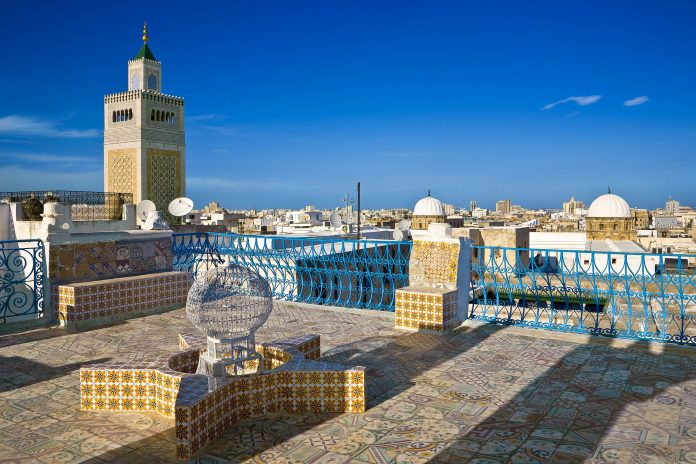In der Medina von Tunis, das historische Zentrum der tunesischen Hauptstadt, entstanden in einem Zeitraum von nahezu 1.500 Jahren an die 700 prachtvolle Baudenkmäler verschiedenster Kulturen.
Tunis, die Hauptstadt von Tunesien, ist eine der ältesten Städte am Mittelmeer. Die Medina (historische Altstadt) von Tunis entstand im 7. Jahrhundert und beherbergt an die 700 prachtvolle Paläste, Moscheen, Madresen (Koranschulen) und Mausoleen. 1979 wurde die Medina von Tunis von der UNESCO zum Weltkulturerbe erklärt.
Geschichte von Tunis in aller Kürze
Tunis wurde bereits im 9. Jahrhundert vor Christus von Phöniziern gegründet, stand jedoch jahrhundertelang im Schatten des mächtigen Karthago, welches zuerst unter den Puniern und dann unter den Römern zur bedeutendsten Stadt Nordafrikas wurde. Erst Ende des 7. Jahrhunderts, als Karthago von den Arabern zerstört wurde, begann die Glanzzeit von Tunis. Unter der anschließenden Herrschaft der Aghlabiden entstand die heutige Medina (Altstadt) von Tunis.
Tunis unterstand in den darauffolgenden Jahrhunderten vieler verschiedener Herrscher. Nach den Aghlabiden kamen die Almohaden, danach die Türken, die Spanier und wieder die Türken, unter denen Tunis zu einem bedeutenden Handelszentrum wurde.
+Anfang des 17. Jahrhunderts siedelten Flüchtlinge aus Andalusien in Tunis und verhalfen der Stadt zu weiterem wirtschaftlichem und kulturellem Wachstum. Neben der historischen Medina entstand eine europäisch angehauchte Neustadt. Als Tunesien 1956 unabhängig wurde, wanderten viele Europäer aus Tunis in ihre ursprüngliche Heimat aus, doch viele Einheimische aus der ländlichen Umgebung zogen in die Stadt und Tunis wurde weiter ausgebaut.
Sehenswürdigkeiten der Medina von Tunis
Die Medina von Tunis beherbergt auf einer Fläche von 270 Hektar etwa ein Zehntel der Bevölkerung von Tunis. Die Medina wurde nicht strukturiert, etwa nach Schachbrettmuster, errichtet, sondern ist natürlich gewachsen. Und so gibt es ein Wohnviertel mit Häusern und Palästen, ein offizielles Viertel mit Bibliotheken und Verwaltungsgebäuden und ein religiöses Viertel mit Moscheen und Zaouias (Stätten der Heiligenverehrung). Straßen wurden nicht als Durchzugsstraßen angelegt, sondern um die Häuser miteinander zu verbinden.
Die gesamte Medina von Tunis ist ein einzigartiger Schmelztiegel aus jahrhundertelangen architektonischen Einflüssen der Araber, Berber, Andalusier, Türken, Römer und Byzantiner, der zu den besterhaltenen historischen Stadtkernen der arabischen Welt zählt. Von imposanten historischen Toren umschlossen taucht der Besucher in eine faszinierende Welt aus Tausendundeiner Nacht ein. Neben mittelalterlichen Bauten hat die Medina von Tunis auch architektonische Juwelen aus dem 17., 18. und 19. Jahrhundert zu bieten.
Es ist aufgrund der unendlich vielen verwinkelten Gassen kaum möglich, die Medina von Tunis strukturiert zu erforschen. Lassen Sie sich stattdessen einfach von dem bunten Treiben mitreißen und genießen Sie die massenhaften Eindrücke einer fremden Welt aus einer scheinbar längst vergangenen Zeit.
Zitouna-Moschee

Die Zitouna Moschee („Oliven-Moschee“) liegt im Herzen der Medina und ist wohl die bedeutendste Sehenswürdigkeit der Medina von Tunis. Die imposante Moschee wurde im Jahr 723 vom Aghlabiden-Herrscher Obeid Allah Ibn-al-Habhab errichtet, um Tunis nach der Eroberung als seine neue Hauptstadt zu feiern.
Die antiken und byzantinischen Säulen, die in der Moschee Verwendung gefunden haben, stammen aus dem zuvor zerstörten Karthago. Die Zitouna Moschee beinhaltet außerdem die muslimische Universität mit einer umfassenden Bibliothek.
Dar-al-Bey Palast
Der Dar-al-Bey-Palast, oder kurz nur Bey-Palast ist eine attraktive Mischung aus mehreren architektonischen und dekorativen Stilen. Er stammt aus dem frühen 19. Jahrhundert und soll auf den Überresten eines römischen Amphitheaters und eines Aghlabiden-Palastes aus dem 10. Jahrhundert errichtet worden sein.
Adelshäuser
Die Medina von Tunis beherbergt prachtvolle Wohnhäuser der Oberschicht von Tunis, darunter das Dar Ben Abdallah, das Dar el-Bey oder das Dar Soulaimania, in dem einst die Aufnahmen an die Zaitouna-Universität stattfanden.
Souks (Märkte) von Tunis
Rund um die großen Bauten der Medina von Tunis breitet sich auf etwa 1,5km Länge und 800m Breite ein regelrechtes Wirrwarr von Gassen aus, die von den Souks (Märkten) von Tunis erobert wurden. In dem engen Labyrinth aus Straßen wird mit den Händlern lautstark um den Preis von exotischen Gewürzen, kostbaren Teppichen, handgefertigtem Schmuck und hübschen Souvenirs gefeilscht.
Tipp: Besuchen Sie auch die Nebengassen des Souks von Tunis. Auf den Hauptstraßen sind die Händler auf die Touristenzüge eingestellt, doch abseits der lauten Stände finden Sie bestimmt die eine oder andere interessante Werkstatt, schmucke Läden und freundliche Menschen.





